- Home
- Walter Isaacson
Walter Isaacson Great Innovators e-book boxed set Page 3
Walter Isaacson Great Innovators e-book boxed set Read online
Page 3
His father continued to refurbish and resell used cars, and he festooned the garage with pictures of his favorites. He would point out the detailing of the design to his son: the lines, the vents, the chrome, the trim of the seats. After work each day, he would change into his dungarees and retreat to the garage, often with Steve tagging along. “I figured I could get him nailed down with a little mechanical ability, but he really wasn’t interested in getting his hands dirty,” Paul later recalled. “He never really cared too much about mechanical things.”
“I wasn’t that into fixing cars,” Jobs admitted. “But I was eager to hang out with my dad.” Even as he was growing more aware that he had been adopted, he was becoming more attached to his father. One day when he was about eight, he discovered a photograph of his father from his time in the Coast Guard. “He’s in the engine room, and he’s got his shirt off and looks like James Dean. It was one of those Oh wow moments for a kid. Wow, oooh, my parents were actually once very young and really good-looking.”
Through cars, his father gave Steve his first exposure to electronics. “My dad did not have a deep understanding of electronics, but he’d encountered it a lot in automobiles and other things he would fix. He showed me the rudiments of electronics, and I got very interested in that.” Even more interesting were the trips to scavenge for parts. “Every weekend, there’d be a junkyard trip. We’d be looking for a generator, a carburetor, all sorts of components.” He remembered watching his father negotiate at the counter. “He was a good bargainer, because he knew better than the guys at the counter what the parts should cost.” This helped fulfill the pledge his parents made when he was adopted. “My college fund came from my dad paying $50 for a Ford Falcon or some other beat-up car that didn’t run, working on it for a few weeks, and selling it for $250—and not telling the IRS.”
The Jobses’ house and the others in their neighborhood were built by the real estate developer Joseph Eichler, whose company spawned more than eleven thousand homes in various California subdivisions between 1950 and 1974. Inspired by Frank Lloyd Wright’s vision of simple modern homes for the American “everyman,” Eichler built inexpensive houses that featured floor-to-ceiling glass walls, open floor plans, exposed post-and-beam construction, concrete slab floors, and lots of sliding glass doors. “Eichler did a great thing,” Jobs said on one of our walks around the neighborhood. “His houses were smart and cheap and good. They brought clean design and simple taste to lower-income people. They had awesome little features, like radiant heating in the floors. You put carpet on them, and we had nice toasty floors when we were kids.”
Jobs said that his appreciation for Eichler homes instilled in him a passion for making nicely designed products for the mass market. “I love it when you can bring really great design and simple capability to something that doesn’t cost much,” he said as he pointed out the clean elegance of the houses. “It was the original vision for Apple. That’s what we tried to do with the first Mac. That’s what we did with the iPod.”
Across the street from the Jobs family lived a man who had become successful as a real estate agent. “He wasn’t that bright,” Jobs recalled, “but he seemed to be making a fortune. So my dad thought, ‘I can do that.’ He worked so hard, I remember. He took these night classes, passed the license test, and got into real estate. Then the bottom fell out of the market.” As a result, the family found itself financially strapped for a year or so while Steve was in elementary school. His mother took a job as a bookkeeper for Varian Associates, a company that made scientific instruments, and they took out a second mortgage. One day his fourth-grade teacher asked him, “What is it you don’t understand about the universe?” Jobs replied, “I don’t understand why all of a sudden my dad is so broke.” He was proud that his father never adopted a servile attitude or slick style that may have made him a better salesman. “You had to suck up to people to sell real estate, and he wasn’t good at that and it wasn’t in his nature. I admired him for that.” Paul Jobs went back to being a mechanic.
His father was calm and gentle, traits that his son later praised more than emulated. He was also resolute. Jobs described one example:
Nearby was an engineer who was working at Westinghouse. He was a single guy, beatnik type. He had a girlfriend. She would babysit me sometimes. Both my parents worked, so I would come here right after school for a couple of hours. He would get drunk and hit her a couple of times. She came over one night, scared out of her wits, and he came over drunk, and my dad stood him down—saying “She’s here, but you’re not coming in.” He stood right there. We like to think everything was idyllic in the 1950s, but this guy was one of those engineers who had messed-up lives.
What made the neighborhood different from the thousands of other spindly-tree subdivisions across America was that even the ne’er-do-wells tended to be engineers. “When we moved here, there were apricot and plum orchards on all of these corners,” Jobs recalled. “But it was beginning to boom because of military investment.” He soaked up the history of the valley and developed a yearning to play his own role. Edwin Land of Polaroid later told him about being asked by Eisenhower to help build the U-2 spy plane cameras to see how real the Soviet threat was. The film was dropped in canisters and returned to the NASA Ames Research Center in Sunnyvale, not far from where Jobs lived. “The first computer terminal I ever saw was when my dad brought me to the Ames Center,” he said. “I fell totally in love with it.”
Other defense contractors sprouted nearby during the 1950s. The Lockheed Missiles and Space Division, which built submarine-launched ballistic missiles, was founded in 1956 next to the NASA Center; by the time Jobs moved to the area four years later, it employed twenty thousand people. A few hundred yards away, Westinghouse built facilities that produced tubes and electrical transformers for the missile systems. “You had all these military companies on the cutting edge,” he recalled. “It was mysterious and high-tech and made living here very exciting.”
In the wake of the defense industries there arose a booming economy based on technology. Its roots stretched back to 1938, when David Packard and his new wife moved into a house in Palo Alto that had a shed where his friend Bill Hewlett was soon ensconced. The house had a garage—an appendage that would prove both useful and iconic in the valley—in which they tinkered around until they had their first product, an audio oscillator. By the 1950s, Hewlett-Packard was a fast-growing company making technical instruments.
Fortunately there was a place nearby for entrepreneurs who had outgrown their garages. In a move that would help transform the area into the cradle of the tech revolution, Stanford University’s dean of engineering, Frederick Terman, created a seven-hundred-acre industrial park on university land for private companies that could commercialize the ideas of his students. Its first tenant was Varian Associates, where Clara Jobs worked. “Terman came up with this great idea that did more than anything to cause the tech industry to grow up here,” Jobs said. By the time Jobs was ten, HP had nine thousand employees and was the blue-chip company where every engineer seeking financial stability wanted to work.
The most important technology for the region’s growth was, of course, the semiconductor. William Shockley, who had been one of the inventors of the transistor at Bell Labs in New Jersey, moved out to Mountain View and, in 1956, started a company to build transistors using silicon rather than the more expensive germanium that was then commonly used. But Shockley became increasingly erratic and abandoned his silicon transistor project, which led eight of his engineers—most notably Robert Noyce and Gordon Moore—to break away to form Fairchild Semiconductor. That company grew to twelve thousand employees, but it fragmented in 1968, when Noyce lost a power struggle to become CEO. He took Gordon Moore and founded a company that they called Integrated Electronics Corporation, which they soon smartly abbreviated to Intel. Their third employee was Andrew Grove, who later would grow the company by shifting its focus from memory chips to microprocessors. Within a f
ew years there would be more than fifty companies in the area making semiconductors.
The exponential growth of this industry was correlated with the phenomenon famously discovered by Moore, who in 1965 drew a graph of the speed of integrated circuits, based on the number of transistors that could be placed on a chip, and showed that it doubled about every two years, a trajectory that could be expected to continue. This was reaffirmed in 1971, when Intel was able to etch a complete central processing unit onto one chip, the Intel 4004, which was dubbed a “microprocessor.” Moore’s Law has held generally true to this day, and its reliable projection of performance to price allowed two generations of young entrepreneurs, including Steve Jobs and Bill Gates, to create cost projections for their forward-leaning products.
The chip industry gave the region a new name when Don Hoefler, a columnist for the weekly trade paper Electronic News, began a series in January 1971 entitled “Silicon Valley USA.” The forty-mile Santa Clara Valley, which stretches from South San Francisco through Palo Alto to San Jose, has as its commercial backbone El Camino Real, the royal road that once connected California’s twenty-one mission churches and is now a bustling avenue that connects companies and startups accounting for a third of the venture capital investment in the United States each year. “Growing up, I got inspired by the history of the place,” Jobs said. “That made me want to be a part of it.”
Like most kids, he became infused with the passions of the grown-ups around him. “Most of the dads in the neighborhood did really neat stuff, like photovoltaics and batteries and radar,” Jobs recalled. “I grew up in awe of that stuff and asking people about it.” The most important of these neighbors, Larry Lang, lived seven doors away. “He was my model of what an HP engineer was supposed to be: a big ham radio operator, hard-core electronics guy,” Jobs recalled. “He would bring me stuff to play with.” As we walked up to Lang’s old house, Jobs pointed to the driveway. “He took a carbon microphone and a battery and a speaker, and he put it on this driveway. He had me talk into the carbon mike and it amplified out of the speaker.” Jobs had been taught by his father that microphones always required an electronic amplifier. “So I raced home, and I told my dad that he was wrong.”
“No, it needs an amplifier,” his father assured him. When Steve protested otherwise, his father said he was crazy. “It can’t work without an amplifier. There’s some trick.”
“I kept saying no to my dad, telling him he had to see it, and finally he actually walked down with me and saw it. And he said, ‘Well I’ll be a bat out of hell.’”
Jobs recalled the incident vividly because it was his first realization that his father did not know everything. Then a more disconcerting discovery began to dawn on him: He was smarter than his parents. He had always admired his father’s competence and savvy. “He was not an educated man, but I had always thought he was pretty damn smart. He didn’t read much, but he could do a lot. Almost everything mechanical, he could figure it out.” Yet the carbon microphone incident, Jobs said, began a jarring process of realizing that he was in fact more clever and quick than his parents. “It was a very big moment that’s burned into my mind. When I realized that I was smarter than my parents, I felt tremendous shame for having thought that. I will never forget that moment.” This discovery, he later told friends, along with the fact that he was adopted, made him feel apart—detached and separate—from both his family and the world.
Another layer of awareness occurred soon after. Not only did he discover that he was brighter than his parents, but he discovered that they knew this. Paul and Clara Jobs were loving parents, and they were willing to adapt their lives to suit a son who was very smart—and also willful. They would go to great lengths to accommodate him. And soon Steve discovered this fact as well. “Both my parents got me. They felt a lot of responsibility once they sensed that I was special. They found ways to keep feeding me stuff and putting me in better schools. They were willing to defer to my needs.”
So he grew up not only with a sense of having once been abandoned, but also with a sense that he was special. In his own mind, that was more important in the formation of his personality.
School
Even before Jobs started elementary school, his mother had taught him how to read. This, however, led to some problems once he got to school. “I was kind of bored for the first few years, so I occupied myself by getting into trouble.” It also soon became clear that Jobs, by both nature and nurture, was not disposed to accept authority. “I encountered authority of a different kind than I had ever encountered before, and I did not like it. And they really almost got me. They came close to really beating any curiosity out of me.”
His school, Monta Loma Elementary, was a series of low-slung 1950s buildings four blocks from his house. He countered his boredom by playing pranks. “I had a good friend named Rick Ferrentino, and we’d get into all sorts of trouble,” he recalled. “Like we made little posters announcing ‘Bring Your Pet to School Day.’ It was crazy, with dogs chasing cats all over, and the teachers were beside themselves.” Another time they convinced some kids to tell them the combination numbers for their bike locks. “Then we went outside and switched all of the locks, and nobody could get their bikes. It took them until late that night to straighten things out.” When he was in third grade, the pranks became a bit more dangerous. “One time we set off an explosive under the chair of our teacher, Mrs. Thurman. We gave her a nervous twitch.”
Not surprisingly, he was sent home two or three times before he finished third grade. By then, however, his father had begun to treat him as special, and in his calm but firm manner he made it clear that he expected the school to do the same. “Look, it’s not his fault,” Paul Jobs told the teachers, his son recalled. “If you can’t keep him interested, it’s your fault.” His parents never punished him for his transgressions at school. “My father’s father was an alcoholic and whipped him with a belt, but I’m not sure if I ever got spanked.” Both of his parents, he added, “knew the school was at fault for trying to make me memorize stupid stuff rather than stimulating me.” He was already starting to show the admixture of sensitivity and insensitivity, bristliness and detachment, that would mark him for the rest of his life.
When it came time for him to go into fourth grade, the school decided it was best to put Jobs and Ferrentino into separate classes. The teacher for the advanced class was a spunky woman named Imogene Hill, known as “Teddy,” and she became, Jobs said, “one of the saints of my life.” After watching him for a couple of weeks, she figured that the best way to handle him was to bribe him. “After school one day, she gave me this workbook with math problems in it, and she said, ‘I want you to take it home and do this.’ And I thought, ‘Are you nuts?’ And then she pulled out one of these giant lollipops that seemed as big as the world. And she said, ‘When you’re done with it, if you get it mostly right, I will give you this and five dollars.’ And I handed it back within two days.” After a few months, he no longer required the bribes. “I just wanted to learn and to please her.”
She reciprocated by getting him a hobby kit for grinding a lens and making a camera. “I learned more from her than any other teacher, and if it hadn’t been for her I’m sure I would have gone to jail.” It reinforced, once again, the idea that he was special. “In my class, it was just me she cared about. She saw something in me.”
It was not merely intelligence that she saw. Years later she liked to show off a picture of that year’s class on Hawaii Day. Jobs had shown up without the suggested Hawaiian shirt, but in the picture he is front and center wearing one. He had, literally, been able to talk the shirt off another kid’s back.
Near the end of fourth grade, Mrs. Hill had Jobs tested. “I scored at the high school sophomore level,” he recalled. Now that it was clear, not only to himself and his parents but also to his teachers, that he was intellectually special, the school made the remarkable proposal that he skip two grades and go right into seventh; it would
be the easiest way to keep him challenged and stimulated. His parents decided, more sensibly, to have him skip only one grade.
The transition was wrenching. He was a socially awkward loner who found himself with kids a year older. Worse yet, the sixth grade was in a different school, Crittenden Middle. It was only eight blocks from Monta Loma Elementary, but in many ways it was a world apart, located in a neighborhood filled with ethnic gangs. “Fights were a daily occurrence; as were shakedowns in bathrooms,” wrote the Silicon Valley journalist Michael S. Malone. “Knives were regularly brought to school as a show of macho.” Around the time that Jobs arrived, a group of students were jailed for a gang rape, and the bus of a neighboring school was destroyed after its team beat Crittenden’s in a wrestling match.
Jobs was often bullied, and in the middle of seventh grade he gave his parents an ultimatum. “I insisted they put me in a different school,” he recalled. Financially this was a tough demand. His parents were barely making ends meet, but by this point there was little doubt that they would eventually bend to his will. “When they resisted, I told them I would just quit going to school if I had to go back to Crittenden. So they researched where the best schools were and scraped together every dime and bought a house for $21,000 in a nicer district.”
The move was only three miles to the south, to a former apricot orchard in Los Altos that had been turned into a subdivision of cookie-cutter tract homes. Their house, at 2066 Crist Drive, was one story with three bedrooms and an all-important attached garage with a roll-down door facing the street. There Paul Jobs could tinker with cars and his son with electronics.
Its other significant attribute was that it was just over the line inside what was then the Cupertino-Sunnyvale School District, one of the safest and best in the valley. “When I moved here, these corners were still orchards,” Jobs pointed out as we walked in front of his old house. “The guy who lived right there taught me how to be a good organic gardener and to compost. He grew everything to perfection. I never had better food in my life. That’s when I began to appreciate organic fruits and vegetables.”

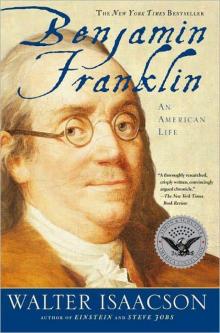 Benjamin Franklin: An American Life
Benjamin Franklin: An American Life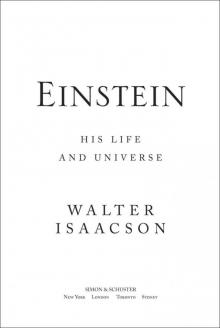 Einstein: His Life and Universe
Einstein: His Life and Universe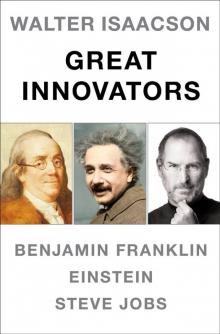 Walter Isaacson Great Innovators e-book boxed set
Walter Isaacson Great Innovators e-book boxed set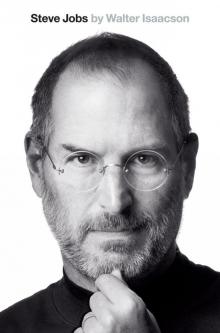 Steve Jobs
Steve Jobs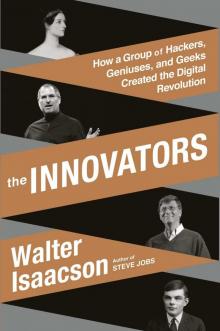 The Innovators
The Innovators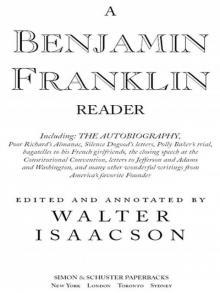 A Benjamin Franklin Reader
A Benjamin Franklin Reader